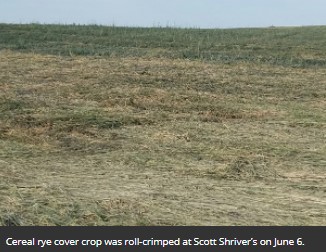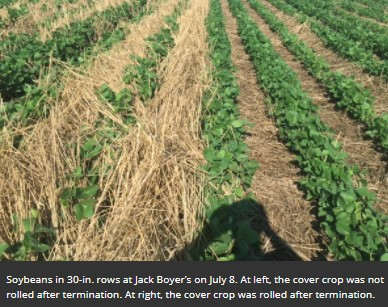By Stefan Gailans
Cover crops are gaining new attention for their ability to reduce weed pressure in soybeans. Specifically, when seeding soybeans directly into a thick cover crop. In the past two years, farmer-researchers Jeremy Gustafson and Jack Boyer have documented reduced herbicide use when planting soybeans into a tall, thick cereal rye cover crop that they chemically terminated near the time of soybean planting (Cereal Rye Cover Crop Termination Date Ahead of Soybeans). In this new project, farmer-cooperators Jack Boyer and Scott Shriver investigated the effect of row-width on soybean yields when rolling a cereal rye cover crop. Boyer rolled select strips after terminating with an herbicide; Shriver used a roller-crimper to terminate his cover crop.
How was the trial conducted?
This trial was conducted by Jack Boyer near Reinbeck in Tama County and Scott Shriver (certified organic) near Jefferson in Greene County. At both farms, treatments were replicated four times in side-by-side strips running the length of the field. Cereal rye cover crop was drilled on Oct. 1, 2016 at a rate of 50 lb/ac at Boyer’s and on Oct. 11 at a rate of 160 lb/ac at Shriver’s.
Treatments at Boyer’s:
- Soybean row-width: 10-in. vs. 30-in. Seeded 5 days prior to cover crop termination.
- Cover crop termination: Spray, then roll cover into flat mulch vs. Spray, then let cover stand.
Treatments at Shriver’s:
- Soybean row-width: 7.5-in. vs. 15-in. vs. 30-in. Seeded 5 days prior to roll-crimping cover crop.
Findings
At Boyer’s, drilling the soybeans in 10-in. rows scored top yields regardless of whether the cover crop was rolled or not. “In general, I did not see a benefit from rolling the rye when using my usual seeding method of drilling,” Boyer said. “I believe that this is partially due to the harrow behind the drill performing some of the same effects as rolling.” Drilling soybeans in 10-in. rows and not rolling the terminated cover crop also netted Boyer the greatest returns on investment from the cover crop (less passes across the field!). In-season weed control was achieved entirely with the cover crop mulch (either rolled or left standing). In other words, after terminating the cover crop, Boyer did not need to spray again for weeds.

Boyer did experience some difficulty while harvesting the soybeans in 30-in. rows where the cover crop was not rolled. “The rye was standing between the rows and had a tendency to bunch up and create a blockage [while combining],” he said. “In the 10-in. rows the drill apparently laid the rye down enough that it was not as much of a problem.” Boyer also estimated that the final stand in the not-rolled, 30-in. row-width treatment was approximately 30% lower than the other treatments.

Shriver also saw his best yields with the narrowest row-width he used: 7.5-in. Soybean plant populations and yields were drastically reduced with the 15- and 30-in. row-widths. He noted some difficulty planting into very thick cover crop residue (15,165 lb/ac) in early June (i.e., closing the seed trench). “I had an overall problem in the field of getting the soybeans to grow and I think it was mostly due to poor planting (open seed trench, planter penetration, seed to soil contact, etc.) heightened by lack of rainfall,” he said. Shriver accomplished the different row-widths by offsetting his planter with auto steering and making multiple passes over the same area to get the 15- and 7.5-in. row-widths. “I believe these multiple passes helped the previous passes with their poor planting issues. Therefore, I do not believe we can conclude that the yield differences are solely from the different row spacings.”
Click here to see more...